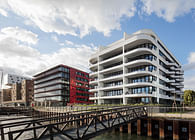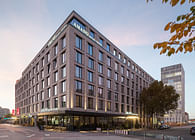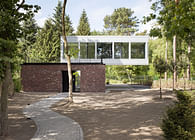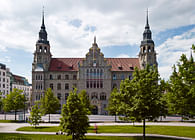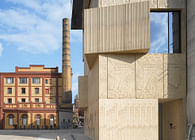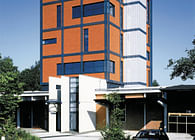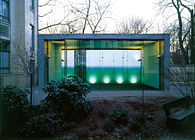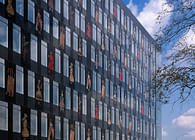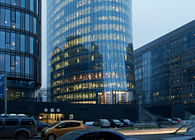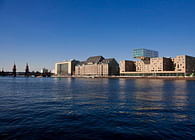
Berlin, DE
New office building and loft house
In close proximity to such prestigious buildings as the Reichstag and the Chancellery, this building complex completes a block in the north of the Friedrichstadt. Its location adjacent to a commuter railway route determined the basic architectural form: the front beams of the office building form a concave curve facing the opposing curve of the viaduct, spanning a narrow public space between building and railway.
From here the noise- and heat-insulating façade soars some 30 m high, functioning year round as a climatic buffer zone. In winter it converts sun rays into long-wave radiation and mitigates wind chill with close ventilation, while in summer a chimney effect draws cool air mechanically from the shadow of the viaduct; the air skims the concrete façade to cooling effect before finally discharging upwards. At the same time the lobby absorbs noise emissions from the railway by up to 10 dB(a). The challenges presented by the geometry are met by a tiered polygonal schema comprising vertical glass panes made using purely orthogonal glass-cutting methods. This results in a faceted image of constantly changing reflections and vistas.
The punctuated façade is made of coloured artificial stone. The circumferential stripes of its distinctive relief surface structure the space and disperse echoes within the lobby. All windows apart from those in the lobby are in box window format. The upper level is surrounded by homogenous post-and-beam glazing with enamelled intermediate bays.
The three-storey loft building is located in the inner area of the block, shielded by the higher perimeter structure. Mediating between the nearby end wall and the courtyard wing of the front wall, this loft building asserts its formal autonomy through the stark design of its façade, unusual use of materials and distinctive colour scheme.
All inner spaces have access to the perimeter, some at ground level, and some as roof terraces. They can be shielded from sight and light by storey-high moving elements made from gold-anodised aluminium sheeting, or allow generous apertures through use of sliding, folding windows. The individual, graded perforation of the aluminium elements lends this normally repetitive semi-finished product a vital character and creates a varying façade within the characteristic large-format style of a factory building.
Status: Built
Location: Reinhardtstraße 48 – 52 / Unterbaumstraße 4-6, 10117 Berlin
Firm Role: Architect: Sergei Tchoban Project manager and partner: Philipp Bauer Team: Dirk Kollendt, Juliane v. Klitzing, Felicia Trauttmansdorff
Additional Credits: Project management: Cenda Plantec GmbH
Landscape architecture: Schrickel & Partner
Statics: LAP Leonhard Andrä and Partners
Building services: IGL Ingenieurgesellschaft Lang


